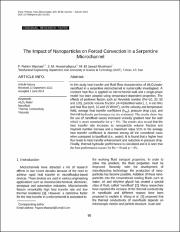The Impact of Nanoparticles on Forced Convection in a Serpentine Microchannel
(ندگان)پدیدآور
Rahim Mashaei, P.Hosseinalipour, S.M.El Jawad Muslmani, M.نوع مدرک
TextOriginal Research Paper
زبان مدرک
Englishچکیده
In this study heat transfer and fluid flow characteristics of Al2O3/water nanofluid in a serpentine microchannel is numerically investigated. A constant heat flux is applied on microchannel wall and a single-phase model has been adopted using temperature-dependent properties. The effects of pertinent factors such as Reynolds number (Re=10, 20, 50 and 100), particle volume fraction (𝛷=0(distilled water), 2, 4 and 8%) and heat flux (q=5, 10 and 15 W/cm2), on the velocity and temperature field, average heat transfer coefficient (havg), pressure drop (Δp), and thermal-hydraulic performance (η) are evaluated. The results show that the use of nanofluid causes increased velocity gradient near the wall which is more remarkable for φ = 8%. The results also reveal that the heat transfer rate increases as nanoparticle volume fraction and Reynold number increase and a maximum value 51% in the average heat transfer coefficient is detected among all the considered cases when compared to basefluid (i.e., water). It is found that a higher heat flux leads to heat transfer enhancement and reduction in pressure drop. Finally, thermal-hydraulic performance is calculated and it is seen that the best performance occurs for Re =10 and φ = 4%.
کلید واژگان
Al2O3/waterViscosity
thermal conductivity
Nanofluid
شماره نشریه
2تاریخ نشر
2014-07-011393-04-10
ناشر
University of Sistan and Baluchestan, Iranian Society Of Mechanical Engineersسازمان پدید آورنده
Mechanical Engineering Department, Iran University of Science and Technology (IUST), Tehran, I.R. IranMechanical Engineering Department, Iran University of Science and Technology (IUST), Tehran, I.R. Iran
Mechanical Engineering Department, Iran University of Science and Technology (IUST), Tehran, I.R. Iran
شاپا
2322-36342588-4298





